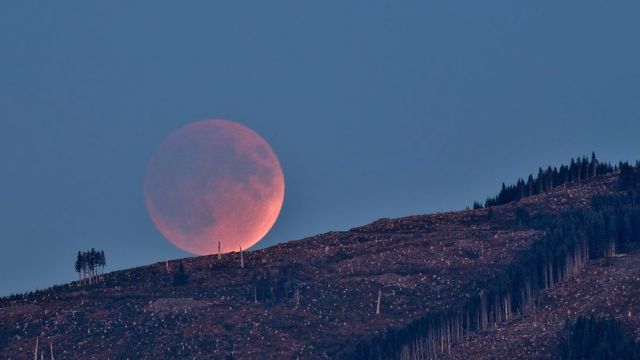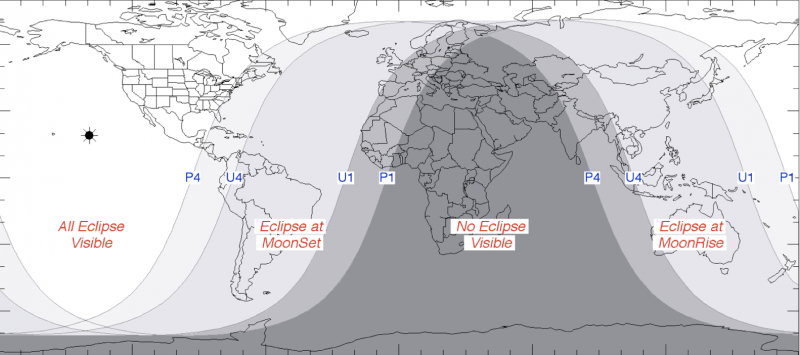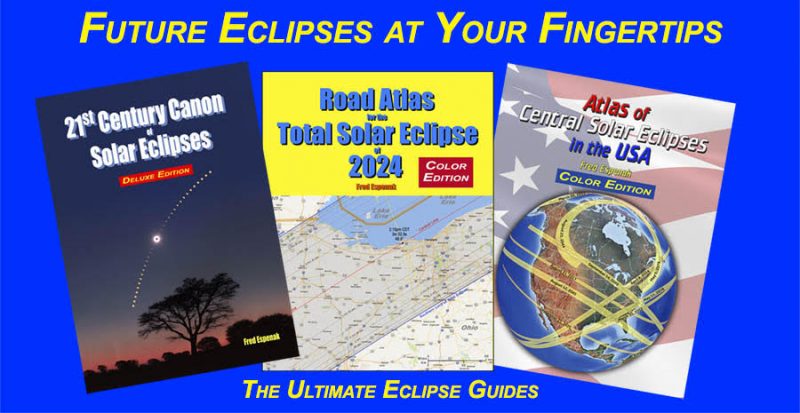
Partial lunar eclipse
A partial lunar eclipse will darken the moon for much of the globe on November 19, 2021. Most locations will see up to 97 percent of the moon slip into Earth’s shadow. North America has the best location to see the entirety of the eclipse. Find maps and timing for the eclipse below, and remember to convert UTC to your time. You can visit TimeandDate.com to get an exact timing of the eclipse from your location.
This is an exceptionally deep partial eclipse with an umbral eclipse magnitude of 0.9742. With a just thin sliver of the moon exposed to direct sun at maximum eclipse, the rest of the moon should take on the characteristically ruddy colors of a total lunar eclipse.
The entire event is visible from North America and the Pacific Ocean. Alaska, eastern Australia, New Zealand and Japan. Observers in western Asia, Australia, and New Zealand miss the early stages of the eclipse because they occur before moonrise. Similarly, South America and Western Europe experience moonset before the eclipse ends. None of the eclipse is visible from Africa, the Middle East, and western Asia.
This is the 2nd lunar eclipse of 2021. It occurs at the moon’s ascending node in Taurus 1.7 days before the moon reaches apogee (Nov 21 02:14 UT1).


Eclipse times
The times of the major eclipse phases are listed as follows. These times are in Universal Time (UT); translate UT to your time.
Penumbral Eclipse Begins: 06:02:09 UT
Partial Eclipse Begins: 07:18:43 UT
Greatest Eclipse: 09:02:56 UT
Partial Eclipse Ends: 10:47:07 UT
Penumbral Eclipse Ends: 12:03:44 UT
At the instant of greatest eclipse (09:02:56 UT) the moon lies at the zenith for a point in the Pacific Ocean east of the Hawaiian Islands. The moon’s southern limb lies 0.8 arc-minutes outside the edge of the umbral shadow. This is an extraordinary test case for a marginally partial eclipse.
Also see this Key to Lunar Eclipse Figures.
Saros and eclipse season
The eclipse belongs to Saros 126 and is number 45 of 70 eclipses in the series.
All eclipses in this series occur at the moon’s ascending node. The moon moves southward with respect to the node with each succeeding eclipse in the series and gamma decreases.
The partial lunar eclipse of November 19, 2021, is followed two weeks later by a total solar eclipse on December 4, 2021.
These eclipses all take place during a single eclipse season.
Read more at AstroPixels

Bottom line: A partial lunar eclipse will occur on Friday, November 19, 2021. It will be visible from the Americas, North Europe, eastern Asia, Australia, and the Pacific. Find timing for your location at TimeandDate.com
The post Partial lunar eclipse of November 19, 2021 first appeared on EarthSky.
from EarthSky https://ift.tt/3uaco4l

Partial lunar eclipse
A partial lunar eclipse will darken the moon for much of the globe on November 19, 2021. Most locations will see up to 97 percent of the moon slip into Earth’s shadow. North America has the best location to see the entirety of the eclipse. Find maps and timing for the eclipse below, and remember to convert UTC to your time. You can visit TimeandDate.com to get an exact timing of the eclipse from your location.
This is an exceptionally deep partial eclipse with an umbral eclipse magnitude of 0.9742. With a just thin sliver of the moon exposed to direct sun at maximum eclipse, the rest of the moon should take on the characteristically ruddy colors of a total lunar eclipse.
The entire event is visible from North America and the Pacific Ocean. Alaska, eastern Australia, New Zealand and Japan. Observers in western Asia, Australia, and New Zealand miss the early stages of the eclipse because they occur before moonrise. Similarly, South America and Western Europe experience moonset before the eclipse ends. None of the eclipse is visible from Africa, the Middle East, and western Asia.
This is the 2nd lunar eclipse of 2021. It occurs at the moon’s ascending node in Taurus 1.7 days before the moon reaches apogee (Nov 21 02:14 UT1).


Eclipse times
The times of the major eclipse phases are listed as follows. These times are in Universal Time (UT); translate UT to your time.
Penumbral Eclipse Begins: 06:02:09 UT
Partial Eclipse Begins: 07:18:43 UT
Greatest Eclipse: 09:02:56 UT
Partial Eclipse Ends: 10:47:07 UT
Penumbral Eclipse Ends: 12:03:44 UT
At the instant of greatest eclipse (09:02:56 UT) the moon lies at the zenith for a point in the Pacific Ocean east of the Hawaiian Islands. The moon’s southern limb lies 0.8 arc-minutes outside the edge of the umbral shadow. This is an extraordinary test case for a marginally partial eclipse.
Also see this Key to Lunar Eclipse Figures.
Saros and eclipse season
The eclipse belongs to Saros 126 and is number 45 of 70 eclipses in the series.
All eclipses in this series occur at the moon’s ascending node. The moon moves southward with respect to the node with each succeeding eclipse in the series and gamma decreases.
The partial lunar eclipse of November 19, 2021, is followed two weeks later by a total solar eclipse on December 4, 2021.
These eclipses all take place during a single eclipse season.
Read more at AstroPixels

Bottom line: A partial lunar eclipse will occur on Friday, November 19, 2021. It will be visible from the Americas, North Europe, eastern Asia, Australia, and the Pacific. Find timing for your location at TimeandDate.com
The post Partial lunar eclipse of November 19, 2021 first appeared on EarthSky.
from EarthSky https://ift.tt/3uaco4l

Aucun commentaire:
Enregistrer un commentaire